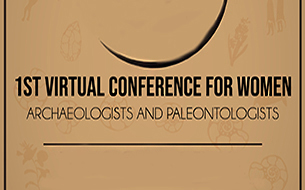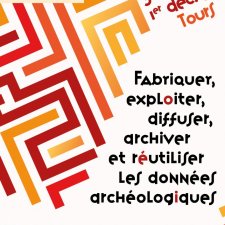Notice
Study on the origins of iron metallurgy in North-East Madagascar (11th-16th century): Reinvention or technology transfer? / Mélissa Morel
- document 1 document 2 document 3
- niveau 1 niveau 2 niveau 3
Descriptif
Study on the origins of iron metallurgy in North-East Madagascar (11th-16th century): Reinvention or technology transfer? / Mélissa Morel, in colloque "1st Virtual Conference for Women Archaeologists and Paleontologists. Nouveaux apports à l’étude des populations et environnements passés" organisé par le laboratoire Travaux et Recherches Archéologiques sur les Cultures, les Espaces et les Sociétés (TRACES) de l’Université Toulouse Jean Jaurès et le laboratoire Paléontologie Évolution Paléoécosystèmes (PALEVOPRIM) de l'Université de Poitiers, sous la responsabilité scientifique de Julie Bachellerie, Ana Belén Galán López (Traces), Émilie Berlioz et Margot Louail (Palevoprim). Université Toulouse Jean Jaurès, 8-9 mars 2021. [Conférence enregistrée à distance].
Session 3 : Exploitation of natural resources and raw materials, subsistence strategies.
Recent survey and excavation missions on the North-East coast of Madagascar (2017-2020) have enabled the identification of numerous iron production workshops between the modern town of Vohémar and Cape Masoala. Radiocarbon dating estimates that the smelting activities took place between the 11th and 16th centuries. The detailed study of the metallurgical wastes and of the spatial organization of the workshops as well as laboratory analyses (XRF, XRD, optical microscope and SEM) helped to reconstruct the technology. The furnace forms a bowl dug directly into the sand without any clay lining. A single shortcylindrical tuyere was wedged in a wall made of sand. No other superstructure could be identified during the excavations. Lateritic concretions with high iron content have been smelted as iron ore.
This area of Madagascar was occupied between the 7th and the 16th century by the so-called Rasikajy. This population was Islamized and participated actively in the Great Indian Ocean Trade. The Rasikajy were thus in contact with a wide variety of foreign populations who had mastered the art of making iron. A comparison of the iron smelting technology studied in northeastern Madagascar with known technologies around the Indian Ocean (fromEast Africa to China via India and Arabia) would help to better understand the geographical origin and transfer modalities of the Rasikajy technology.
Thème
Documentation
Références documentaires
SERNEELS, Vincent, MOREL, Mélissa, NITSCHE, Christoph, RADIMILAHY, Chantal et al. (2019). Pierre et fer à Madagascar 3. La carrière de Bobalila, SLSA Jahresbericht / Rapport annuel / Annual report 2019. [En ligne : https://www.unifr.ch/geo/archaeometry/en/assets/public/assets/public/uploads/slsa_jb2019_(p291-352)_madagascar-bobalila_low.pdf].
Liens
Programme du colloque "1st Virtual Conference for Women Archaeologists and Paleontologists" (8-9 mars 2021)
Website du Laboratoire Paléontologie Évolution Paléoécosystèmes Paléoprimatologie (PALEVOPRIM)
Livret des résumés des communications du colloque "1st Virtual Conference for Women Archaeologists and Paleontologists. Nouveaux apports à l’étude des populations et environnements passés" (8-9 mars 2021)
Site internet dédié au colloque "1st Virtual Conference for Women Archaeologists and Paleontologists" (8-9 mars 2021)
Dans la même collection
-
Sensivity analysis to morphological changes of the shoulder joint: application to percussio…
BLASI-TOCCACCELI Alicia
Sensivity analysis to morphological changes of the shoulder joint: application to percussion gestures during Oldowan debitage / Alicia Blasi-Toccacceli, in colloque "1st Virtual Conference for
-
"Ouranopithecus macedoniensis" (late Miocene, Greece): analysis of mandibular fragments using …
IOANNIDOU Melania
Ouranopithecus macedoniensis (late Miocene, Greece): analysis of mandibular fragments using 3D geometric morphometrics / Melania Ioannidou, in colloque "1st Virtual Conference for Women
-
Comminution capabilities of extant and fossil anthropoids during molar intercuspation: a preliminar…
WALKER Axelle E. C.
Comminution capabilities of extant and fossil anthropoids during molar intercuspation: a preliminary experiment using a chewing simulator / Axelle E. C. Walker, in colloque "1st Virtual Conference for
-
New sperm whale cranium from the late Miocene and a revised family attribution for the small crown …
ALFSEN Apolline
New sperm whale cranium from the late Miocene and a revised family attribution for the small crown physeteroid Thalassocetus / Apolline Alfsen, in colloque "1st Virtual Conference for Women
-
What is shaping the brain? A perspective on brain size evolution in carnivorans / Margot…
MICHAUD Margot
What is shaping the brain? A perspective on brain size evolution in carnivorans / Margot Michaud, in colloque "1st Virtual Conference for Women Archaeologists and Paleontologists. Nouveaux
-
Postnatal shape changes in the rodent mandible at a macroevolutionary scale / Morgane Dubied
DUBIED Morgane
Postnatal shape changes in the rodent mandible at a macroevolutionary scale / Morgane Dubied, in colloque "1st Virtual Conference for Women Archaeologists and Paleontologists. Nouveaux apports à l
-
Cranial vault healing in modern humans: input of archaeological and clinical data / Aliéno…
LEPETIT Aliénor
Cranial vault healing in modern humans: input of archaeological and clinical data / Aliénor Lepetit, in colloque "1st Virtual Conference for Women Archaeologists and Paleontologists. Nouveaux
-
A transdisciplinary approach to reconstruct the Nilotic socio-ecosystem in Luxor west bank during t…
NICATORE Giulia
A transdisciplinary approach to reconstruct the Nilotic socio-ecosystem in Luxor west bank during the Ptolemaic period (3rd-1st centuries BC.) / Giulia Nicatore, in colloque "1st Virtual Conference
-
From monoliths to megaliths: a new approach on the megalithic burials of southwestern France / Bosc…
BOSCUS Sarah
From monoliths to megaliths: a new approach on the megalithic burials of southwestern France / Boscus Sarah, in colloque "1st Virtual Conference for Women Archaeologists and Paleontologists. Nouveaux
-
Tracing Human Ancestral Migration from its Symbiotic Bacteria / Alexia Nguyen Trung
NGUYEN TRUNG Alexia
Tracing Human Ancestral Migration from its Symbiotic Bacteria / Alexia Nguyen Trung, in colloque "1st Virtual Conference for Women Archaeologists and Paleontologists. Nouveaux apports à l’étude des
-
Foragers and their symbolic landscape. Understanding the role of rock art in the territoriality of …
JOBARD Léa
Foragers and their symbolic landscape. Understanding the role of rock art in the territoriality of Later Stone Age Matobo populations / Léa Jobard, in colloque "1st Virtual Conference for Women
-
Towards a tracking of past bird seasonal migrations through geological times: what could isotopes t…
DUHAMEL Anaïs
Towards a tracking of past bird seasonal migrations through geological times: what could isotopes tell us? / Anaïs Duhamel, in colloque "1st Virtual Conference for Women Archaeologists and
Sur le même thème
-
La base de données « archeometal-armoricain » développée dans le cadre du projet SIDEPROD
MEUNIER Emmanuelle
LE CARLIER DE VESLUD Cécile
Le projet SIDEPROD est né d'un double objectif : d'une part, réaliser une synthèse des données sur la sidérurgie ancienne en Basse-Bretagne, de l'âge du Fer à l'époque Moderne et, d'autre part,
-
Sensivity analysis to morphological changes of the shoulder joint: application to percussio…
BLASI-TOCCACCELI Alicia
Sensivity analysis to morphological changes of the shoulder joint: application to percussion gestures during Oldowan debitage / Alicia Blasi-Toccacceli, in colloque "1st Virtual Conference for
-
"Ouranopithecus macedoniensis" (late Miocene, Greece): analysis of mandibular fragments using …
IOANNIDOU Melania
Ouranopithecus macedoniensis (late Miocene, Greece): analysis of mandibular fragments using 3D geometric morphometrics / Melania Ioannidou, in colloque "1st Virtual Conference for Women
-
Cranial vault healing in modern humans: input of archaeological and clinical data / Aliéno…
LEPETIT Aliénor
Cranial vault healing in modern humans: input of archaeological and clinical data / Aliénor Lepetit, in colloque "1st Virtual Conference for Women Archaeologists and Paleontologists. Nouveaux
-
From monoliths to megaliths: a new approach on the megalithic burials of southwestern France / Bosc…
BOSCUS Sarah
From monoliths to megaliths: a new approach on the megalithic burials of southwestern France / Boscus Sarah, in colloque "1st Virtual Conference for Women Archaeologists and Paleontologists. Nouveaux
-
Study of human group behaviors during the Last Glacial Maximum in the east Carpathian area from zoo…
DEMAY Laëtitia
Study of human group behaviors during the Last Glacial Maximum in the east Carpathian area from zooarchaeological remains / Laëticia Demay, in colloque "1st Virtual Conference for Women Archaeologists
-
From sooty speleothems analysis to the study of occupation dynamics of caves by prehistoric societi…
VANDEVELDE Ségolène
From sooty speleothems analysis to the study of occupation dynamics of caves by prehistoric societies / Ségolène Vandevelde, in colloque "1st Virtual Conference for Women Archaeologists and
-
An analysis of Iron Age Scottish wetland deposition practices /Tiffany Treadway
TREADWAY Tiffany
An analysis of Iron Age Scottish wetland deposition practices / Tiffany Treadway, in colloque "1st Virtual Conference for Women Archaeologists and Paleontologists. Nouveaux apports à l’étude des
-
Gender Trouble: towards a deconstruction of binarity in archaeology / Laura Mary
MARY Laura
Gender Trouble: towards a deconstruction of binarity in archaeology / Laura Mary, in colloque "1st Virtual Conference for Women Archaeologists and Paleontologists. Nouveaux apports à l’étude des
-
“Feeling at home”: integration of Polynesian women inside pre-existing societies of Vanuatu (Melane…
ZINGER Wanda
“Feeling at home”: integration of Polynesian women inside pre-existing societies of Vanuatu (Melanesia) / Wanda Zinger, in colloque "1st Virtual Conference for Women Archaeologists and Paleontologists
-
Identification of embalming material of bird mummies through molecular and compound-specific δ13C a…
MALERGUE Axel
Identification of embalming material of bird mummies through molecular and compound-specific δ13C analyses / Alex Malergue, in colloque "1st Virtual Conference for Women Archaeologists and
-
Analysis of Artefact Form: the application of morphometric methods to archaeology / Renata Pedroso …
ARAUJO Renata Pedroso de
Analysis of Artefact Form: the application of morphometric methods to archaeology / Renata Pedroso de Araujo, in colloque "1st Virtual Conference for Women Archaeologists and Paleontologists. Nouveaux




















